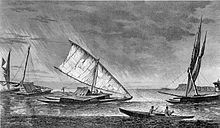Ui-te-Rangiora or Hui Te Rangiora is a legendary Polynesian navigator who sailed to the Southern Ocean and is sometimes claimed to have discovered Antarctica in the early seventh century on the vessel Te Ivi o Atea.[1] The legend originates from the island of Rarotonga in the Cook Islands archipelago, but this island was not populated until the tenth century.[2]

According to a 19th-century interpretation of Rarotongan legend by Stephenson Percy Smith, Ui-te-Rangiora and his crew on the vessel Te Ivi o Atea sailed south and encountered an area he called Tai-uka-a-pia (interpreted by Smith as a frozen sea), "a foggy, misty, and dark place not seen by the sun" where rocks grow out of the sea.[3][1] Smith interpreted this as referring to the ice floes and icebergs in the Southern Ocean, due to the ice floes being similar to arrowroot powder (referring to Tacca leontopetaloides, Polynesian arrowroot).[1] This has led others to conclude that Ui-te-Rangiora was the first person to discover Antarctica.[1][4]
The interpretation of Ui-te-Rangiora reaching Antarctic waters has been questioned.[5] Anderson et al. note that there is no mention of an Antarctic voyage in the original legend, and that it is first mentioned in the story of his descendant Te Aru Tanga Nuku, who wished to "behold all the wonderful things on the ocean" seen by his ancestor.[6] Anthropologist Te Rangi Hīroa assessed the legend as having "so much post-European information" that it cannot be accepted as accurate and ancient.[7] As the Cook Islands Māori language had no pre-European word for 'ice' or 'frozen', interpreting Tai-uka-a-pia as a frozen sea may be a mistranslation, and an alternate interpretation is "sea covered with foam like arrowroot".[8] New Zealand iwi Ngāi Tahu considers the legend to be a mythic origin story rather than a historical voyaging narrative.[9]
It has been suggested that the folklore of the islanders reflected an actual event, namely a sea area covered with a dense layer of floating pieces of pumice resulting from some undersea volcanic eruption. Such a 25 000 km2 sea surface was sighted in 2012 in the area of Kermadec Islands, with a 60 cm thick bright white layer resembling a shelf glacier.[10]

Subantarctic islands
editIt has been claimed that in 1886 Lapita pottery shards were discovered on the Antipodes Islands, indicating that Polynesians did reach that far south.[11] However, the claim has not been substantiated; indeed, no archaeological evidence of human visitation prior to European discovery of the islands has been found.[12]
Enderby Island, considerably south of the Antipodes Islands, has been found to have proof of 13th- or 14th-century Māori use.[13] Similarly, a craft of 'ancient design' was found in 1810 on the subantarctic Macquarie Island, considerably south and west of the Auckland Islands. It has been suggested that the craft was burnt for fuel that year in the ensuing penguin and seal oil fires, and that it was possibly a Polynesian vessel. However, in the same year, Captain Smith described in more detail what is presumably the same wreck: 'several pieces of wreck of a large vessel on this Island, apparently very old and high up in the grass, probably the remains of the ship of the unfortunate De la Perouse.'[14]
References
edit- ^ a b c d Wehi, Priscilla M.; Scott, Nigel J.; Beckwith, Jacinta; Pryor Rodgers, Rata; Gillies, Tasman; Van Uitregt, Vincent; Krushil, Watene (2021). "A short scan of Māori journeys to Antarctica". Journal of the Royal Society of New Zealand. 52 (5): 1–12. doi:10.1080/03036758.2021.1917633. PMC 11485871. PMID 39440197. Cite error: The named reference "Wehi-2021" was defined multiple times with different content (see the help page).
- ^ Alphons M.J. Kloosterman (1976). Discoverers Of The Cook Islands And The Names They Gave. pp. 44–47.
- ^ Smith, Stephenson Percy (1899). "Part III". Hawaiki: the whence of the Maori, being an introduction to Rarotongan history. Vol. 8. The Journal of the Polynesian Society. pp. 10–11.
- ^ McFarlane, Turi (2008). "Maori associations with the Antarctic: Tiri o te Moana ki te Tonga" (PDF). University of Canterbury. Retrieved 11 October 2022.
- ^ Mulvaney, Kieran (2001). At the Ends of the Earth: A History of the Polar Regions. ISBN 9781559639088.
- ^ Anderson, Atholl; O’Regan, Tipene; Parata-Goodall, Puamiria; Stevens, Michael; Tau, Te Maire (September 2021). "On the improbability of pre-European Polynesian voyages to Antarctica: a response to Priscilla Wehi and colleagues". Journal of the Royal Society of New Zealand. 52 (5): 599–605. doi:10.1080/03036758.2021.1973517. PMC 11485678. PMID 39440189. S2CID 239089356.
- ^ Hīroa, Te Rangi (1964). Vikings of the Sunrise. Whitcombe and Tombs Limited. pp. 116–117.
- ^ Anderson, Atholl; O’Regan, Tipene; Parata-Goodall, Puamiria; Stevens, Michael; Tau, Te Maire (2021). "A southern Māori perspective on stories of Polynesian polar voyaging". Polar Record. 57. Bibcode:2021PoRec..57E..42A. doi:10.1017/S0032247421000693. S2CID 244118774.
- ^ "'Our ultimate duty': Defending the integrity of Māori tradition". Te Karaka. Retrieved 11 October 2022.
- ^ Ivanov, Lyubomir; Ivanova, Nusha (2022), The World of Antarctica, Generis Publishing, pp. 63–65, ISBN 979-8-88676-403-1
- ^ "Ngā-Iwi-o-Aotea". Te Ao Hou. No. 59. June 1967. p. 43.
- ^ "Captain Fairchild to the Secretary, Marine Department, Wellington". Appendix to the Journals of the House of Representatives, 1886 Session I, H-24. Wellington: Marine Department. p. 6. Retrieved 9 July 2012. The Museum in which the shard is said to be housed has not been able to locate such an item in its collection, and the original reference to the object in the Museum's collection documentation indicates no reference to Polynesian influences.
- ^ Anderson, Atholl (2005). "Subpolar settlement in South Polynesia". Antiquity. 79 (306). Antiquity Publications: 791–800. doi:10.1017/S0003598X00114930. S2CID 162770473. Retrieved 17 November 2018.
- ^ McNab, Robert (1909). Murihiku: A History of the South Island of New Zealand and the Islands Adjacent and Lying to the South, from 1642 to 1835. Wellington: Whitcombe and Tombs Limited. p. 176.